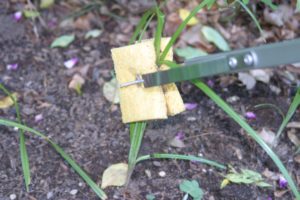Nutsedge (Cyperus esculentus) or nutgrass is a member of the sedge family. This African native plant has thrived and spread throughout the New World. Because of its ability to thrive and persist, most gardeners and farmers consider it a weed.
An edible form of C. esculentus exists in various parts of the world as Chufa, Earth-Almond and Zulu-Nuts. Ancients Egyptians loved Chufas. In fact, archaeologists examining the opened tombs of Pharaohs have often found a small quantity of mummified Chufas in easy reach of the corpses, as if they could be used for snacks. Chufa Nuts have a distinct almond flavor, but are very woody in texture and require a lot of chewing.
Nutsedge Characteristics
There are two primary types of nutsedge here in the Austin area: Purple and Yellow. Both have small tubers that scatter from the plant – a trait which improves its ability to survive many forms of eradication.
| Nutsedge Characteristics | ||
| Purple Nutsedge | Yellow Nutsedge | |
| Leaf Color | dark green | pale or light green |
| Leaf Tip | abruptly tapers to sharp tip | gradually tapers to sharp needle-like tip |
| Rhizomes | wiry, scaly | weak, thread-like |
| Tubers | oblong, coarsely hairy | spherical, smooth |
| Tuber Taste | bitter | sweet |
| Seedhead Color | reddish to purplish-brown | yelllow |
New plants arise from underground tubers. The tuber’s skin contains a chemical substance that inhibits sprouting. Soil moisture “washes” this inhibitor off the tuber allowing it to sprout. This is one reason why the plant thrives in a wet area of the lawn or garden and proliferates during wet spring seasons.
When a nutsedge shoot reaches the surface it forms a basal bulb, from which grow roots with new tubers at their ends. In one year, the outward growth from one tuber has the potential to produce 1,900 new plants and 7,000 new tubers. Luckily individual tubers do not last longer than three years.
Each tuber has up to seven viable buds and enough energy in reserve to sprout all of them. So, if an attempt at control kills one shoot, the tuber merely sends up another. In order for control to be effective, mechanical control must outlast the tubers ability to regenerate, or an herbicide product must translocate down and kill the tuber.
CONTROL METHODS FOR TURF AREAS
There are two products available to aid in the war on netsedge in turf areas. Image (active ingredient is imazaquin) and Manage are labeled for home and commercial turfgrass for use on St. Augustinegrass, bermudagrass, centipedegrass and zoysiagrass. Neither product will wipe it out in one application. Repeat applications will be required for control, as there are always dormant tubers not affected by the treatment which can sprout later in the season.
CONTROL METHODS FOR FLOWERBEDS AND VEGETABLE GARDENS
Organic Control
Nutsedge in flower beds and vegetable gardens can be controlled organically with a combination of hand pulling and summer cultivation. Diligent efforts at frequent spading or rototilling along with picking out tubers that are brought to the surface can go a long way toward reducing an infestation.
It is especially important to begin digging early in the season. By June nutsedge plants have already sent out rhizomes and begun to form additional viable tubers. Thus delaying action results in a significantly greater infestation.
Chemical Control
For larger areas and heavy infestations, the use of a inorganic, contact, translocated herbicide such as glyphosate (Roundup) or glufosinate (Finale) may be considered. Our experience in the Extension test gardens has been that for nutsedge, glyphosate gives more effective long term control. Remember these products kill desirable plants too, so direct spray applications carefully using a coarse, low pressure spray, or apply with a wiper type applicator. You can make a good temporary wiper applicator by attaching a folded rag or piece of sponge over the end of your pump-up garden sprayer nozzle with a rubber band or twisted wire.
In order for optimum results with glyphosate follow these guidelines:
- Complete treatment by June before new rhizomes and viable tubers are formed.
- Apply only to actively growing nutsedge. Allow 3-5 leaves to emerge on new sprouts for best results. Spring to early summer and fall is best. Fall application should be made 4 or 5 weeks before the first frost to allow ample time for the product to be translocated down into the tubers.
- Mix the product at the full label rate.
- Add surfactant (commercial surfactant products are available or, in a pinch, you can use 1 tablespoons of liquid dish soap per gallon of spray mix) to help it stick to the slick leaves of the nutsedge plant.
- Add 1/2 cup of ammonium sulfate (21-0-0) per gallon of spray. Although this may sound strange, it has been found to significantly increase the uptake and effectiveness of glyphosate on many weed species.
Nutsedge, although a tough, formidable foe, is not invincible. With diligent, determined effort and some help from the right herbicide products it can be controlled quite effectively in the home garden and landscape.


